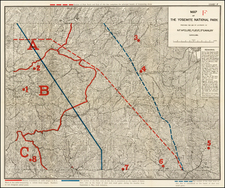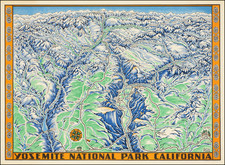Iconic Watkins Mammoth Plate Photograph Print
El Capitan, Yosemite
"Carleton E. Watkins was a giant of photography. He is arguably America's greatest landscape photographer" - Palmquist & Kailbourn
An original mammoth-plate photograph of El Capitan in Yosemite, by the outstanding 19th-century photographer of the American West, Carleton Watkins.
In 1861 Watkins began making his famous large-scale "mammoth-plate" photographs in California's Yosemite Valley -- iconic views that are now unanimously accepted as some of the most beautiful photographic images ever made in the West. These images were influential in persuading the United States Congress to pass pioneering legislation to preserve the Yosemite Valley, which bill, the Yosemite Valley Grant Act, was signed into law by Abraham Lincoln on June 30, 1864. This law granted Yosemite Valley and the Mariposa Grove to the State of California, "to be held for public use, resort, and recreation...[the use of which in this manner] shall be inalienable for all time." Watkins was consulted by Yosemite Commissioner Frederick Law Olmsted on the best means to preserve Yosemite as a public trust. It wasn't until 1890, through the efforts of John Muir and others, that Yosemite was signed into existence as the nation's third National Park.
By whatever means Watkins received his visual education, in 1861 his eye equaled those of the most sophisticated landscape photographers in the world - Weston J. Naef.
While the technical and aesthetic qualities of Watkins's Yosemite photographs were early lauded by enthusiasts and experts alike, including William H. Brewer of the California State Geological Survey ("the finest I have seen"), J. D. Whitney (who named an 8,500-foot peak in Yosemite after Watkins), Edward L. Wilson (editor of the Philadelphia Photographer, who noted that "[Watkins's] camera is mightier than the sword") and Oliver Wendell Holmes (the foremost photography critic of the time who said Watkins's photographs reached "a perfection of art which compares with the finest European work"), it wasn't until the 1970s that Watkins was re-discovered by the photographic art world that a brighter light was focused on his life and work. Watkins's mammoth-plate views of Yosemite are now solidly ensconced as part of the canon of fine art photography. Examples of Watkins's Yosemite photographs are in many great institutional collections, including those in the Bancroft Library, the Getty, the Metropolitan Museum of Art, the Huntington Library, and numerous other institutions.
El Capitan.
The photograph shows a view of El Capitan that Watkins originally photographed in 1861, during his initial photographic expedition with the mammoth-plate camera in the Yosemite Valley. However, the present print conforms to a version dated by Weston Naef to circa 1865-1866. Watkins often returned to the same locations in Yosemite, making numerous photographs of the same subject over time.
This is a viewpoint to which Watkins would return on numerous occasions... This view of El Capitan is a variation on a composition made in 1861, and a precursor to others that would be made more than a decade later. - Weston Naef.
Thus, it could be said that this photograph is a transitional examplar -- certainly the time period in which is was made, ca. 1865, was a transitional moment in Watkins's photographic practice. Before 1867 he conducted his photographic business on an ad hoc basis, mainly in response to customer demand, and he wasn't always consistent in how he signed and captioned his work. While the present print is signed by Watkins, it bears no caption title. After 1867, Watkins consistently signed his prints and also often included a printed typeset caption with copyright information. But perhaps the words of Weston Naef provide the most weight to the transitional nature of the present photograph:
Watkins' first series in Yosemite was flawed in minor ways compared to photographs he made later. Nevertheless, they struck wonder in even his most seasoned contemporaries... About 1866 Watkins' style became more cerebral as he abandoned the elementary picturesqueness of his 1861 work. The transition can be seen, in part, in a series of photographs of El Capitan made between 1861 and 1866 (emphasis added)... The second El Capitan, made sometime between 1864 and 1866, conveys the subtlety of the rock surface and subordinates the picturesque elements in the surrounding landscape to the main subject - the canyon wall. The site was well chosen, and Watkins would return to it repeatedly, photographing the rock face in many different lights....Watkins developed a style of printing his negatives in which the most distant parts are faint. - Weston Naef [in]: Carleton Watkins: Selected Texts and Bibliography, pages 97-99.
Given that Watkins exposed multiple plates from his favored locations, the different lighting and atmospheric conditions of the moment would certainly result in a range of printing outcomes. One reason the water in the foreground appears stronger than El Capitan itself in the present print could be related to the manner in which water absorbs ultraviolet light, reducing the effects of atmospheric conditions such as haze or fog that may have been present at the moment when the plate was exposed.
At some point in 1865-1866 Watkins began assigning his own catalog numbers to his Yosemite photographs, with the present view conforming closely (if not precisely) to CEW 26.
The Mammoth-Plate Camera
Watkins made the negative for this image using his custom-made oversized camera. This camera was constructed by a local San Francisco instrument maker to handle negatives as large as 18 x 22 inches (the so-called mammoth-plate format). It was fitted with a Grubb Aplanatic Landscape lens for wide-angle shots.
Watkins's most famous visit to Yosemite Valley took place in the summer of 1861, when the photographer brought with him for the first time a special camera designed to accommodate sheets of glass 45.7 x 55.9 cm (18 x 22 inches) in size that were popularly called "mammoth plates." Exactly how Watkins procured this highly unusual oversize camera is uncertain. One possibility is that it was fabricated by someone such as Thomas Tennant, who advertised his services in Hutchings's magazine as an instrument maker on Battery Street in San Francisco. - Naef & Hult-Lewis, page 45.
Watkins's Autograph
According to Weston Naef and Michael Hargraves, the style and character of Watkins' handwriting evolved over time. Specifically, the way he formed the W in his name changed from having pointed bottoms to having curved bottoms. This change, which happened sometime in 1861 (or possibly as late as 1863), was accompanied by additional modifications to his signature marked by spaces where he lifted the pen from the writing surface at mid stroke. Oddly enough, by 1872 Watkins had reverted to the pointed-bottom W.
An aid to dating the photograph at hand. Naef and Hargraves state there are few prints with Watkins's autograph signature between about 1865 and 1875. This is because he was too busy in the field, carting around his mammoth-plate camera up and down the Pacific Coast, to be able to sign many prints.
The present photograph bears an autograph signature that conforms in every detail to Watkins's pre-1872 autograph, i.e. it has a curved-bottom W, with instances where he has lifted the pen from the writing surface causing a space interruption in the line. The signature here matches one described in Naef's catalog as having been made by Watkins ca. 1865-1866, and, given the unlikelihood of a 1865-1875 signed print, evidence points to 1865-1866 as the date of the present print.
Rarity
Original signed mammoth plate Yosemite prints by Watkins from this early period (ca. 1865) are rare in the market. Most auction records for sales of this particular Watkins view are of the later "New Series" where the trees on the sandbar in the right foreground are no longer present.
Versions of this image are held in important photographic collections, including: Bancroft Library, UCLA, UC Riverside Museum of Photography, Cooper-Hewitt, the Huntington Library, Metropolitan Museum, New York Public Library.
Carleton Watkins (American, 1829-1916) was one of the most highly acclaimed of early western photographers, yet Watkins's work has never been fully cataloged. No complete listings of his "Old Series" stereoviews, published before 1875, are known.
Watkins extensively photographed early San Francisco, Yosemite, Mendocino and the Sierra Nevada mining regions. His photogaphs of Yosemite helped influence Congress and President Lincoln in the preservation of Yosemite Valley. Watkins also made some of the earliest photographs of Southern California and the Pacific Nortwest. Watkins' Pacific Railroad series documents construction of the trans-continental railroad from Sacramento to Utah.












![(Texas - Comanche Indian Photograph) Tush=a=wa or Whiteknife, Pen=a=teth=ka, Comanche Chief [Cabinet card photograph of Tosahwi, White Knife, or Tosawa; Penateka Comanche Chief]](https://storage.googleapis.com/raremaps/img/small/93032.jpg)
![[Early Landsat Photocomposite of California]](https://storage.googleapis.com/raremaps/img/small/90468.jpg)
![(Native American Photograph) [CDV Photograph of Prairie Indian man, possibly a Kansa or Kickapoo]](https://storage.googleapis.com/raremaps/img/small/93108.jpg)
![(Florida Aviation - Early Photographs) [Original photograph album of Carlstrom Field, Florida, early Army Air Service Training Camp]](https://storage.googleapis.com/raremaps/img/small/84163.jpg)
